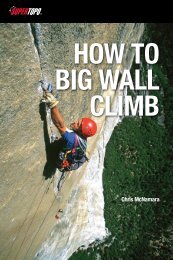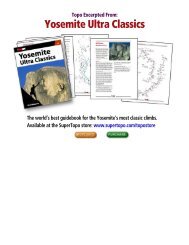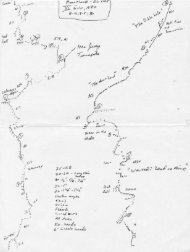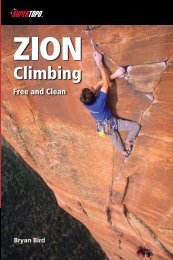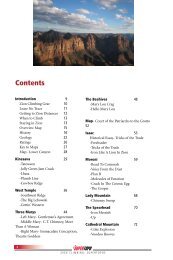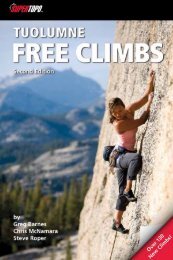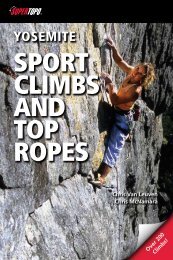The Definitive Guide To Yosemite Big Wall Climbing - SuperTopo
The Definitive Guide To Yosemite Big Wall Climbing - SuperTopo
The Definitive Guide To Yosemite Big Wall Climbing - SuperTopo
Create successful ePaper yourself
Turn your PDF publications into a flip-book with our unique Google optimized e-Paper software.
A5 or C5 Extreme aid: More than nine<br />
bodyweight placements in a row. Eighty-foot<br />
plus fall potential. Most A5 pitches take more<br />
than four hours. Examples: Most El Cap routes,<br />
such as Reticent <strong>Wall</strong> and Nightmare on<br />
California Street, put up in the 90s.<br />
“C” This pitch goes hammerless without relying<br />
on fixed gear. It is highly unlikely that you<br />
need a hammer on these pitches. Examples:<br />
All pitches on <strong>The</strong> Nose, Regular Route on<br />
Half Dome, and the South Face of Washington<br />
Column.<br />
“A” This pitch generally requires a hammer<br />
to place pitons or copperheads. Examples: All<br />
pitches on the Reticent <strong>Wall</strong> and many pitches<br />
on Native Son, Lost in America, Zenith, and Sea<br />
of Dreams.<br />
“F” comes after a “C” rating and denotes a<br />
pitch that relies on fixed gear in order to go<br />
hammerless. Ninety-five percent of the time<br />
pitches marked with “F” go hammerless, but<br />
to be safe put a hammer and a couple of<br />
copperheads and pins in the bottom of the<br />
haulbag in case fixed gear is missing. Don't<br />
remove fixed heads on a trade route unless<br />
it is a timebomb that you are replacing. <strong>The</strong><br />
process of placing and removing copperheads<br />
eventually destroys the crack. A carefully<br />
cleaned piton usually leads to a clean aid<br />
placement. Examples: Many pitches on the<br />
Leaning <strong>To</strong>wer, Prow, and Zodiac.<br />
“R” Dangerous fall potential because of the<br />
possibility of hitting a ledge, swinging into a<br />
corner or running the rope over a sharp edge.<br />
Examples: Black <strong>To</strong>wer pitch on Zodiac (A2R or<br />
C3R) where a fall is possible onto a ramp, Pitch<br />
13 on the Reticent <strong>Wall</strong> (A4R) where the leader<br />
must do numerous hook and head moves above<br />
a ledge.<br />
Note: Just because a pitch does not have an “R”<br />
or an “X” rating does not mean you can’t become<br />
injured or die on that pitch.<br />
“+” indicates a tricky or strenuous section.<br />
Found on either strenuous terrain (roof or<br />
deep corner) or an unusually tricky “boulder<br />
problem” aid move (expanding flake, huge<br />
reach). Pitches marked with a “+” are thought<br />
provoking and often more time consuming.<br />
Examples: <strong>The</strong> Nipple Pitch on Zodiac (C3+F),<br />
Shield Roof (A2+), and Pitch 5 of the South<br />
Face of Washington Column (C1+).<br />
Many people wonder why aid ratings change<br />
over time (e.g. a route that was A5 in 1970<br />
might be A3 today). <strong>The</strong> reason is that all routes<br />
go through a life cycle in which pin placements<br />
become more solid and the strongest<br />
copperhead placements are found and left<br />
fixed. Also, bolts are added both as “chickenbolts”<br />
and because rock features fall off. <strong>To</strong><br />
give a general understanding of this process we<br />
have provided the metamorphosis of a typical<br />
<strong>Yosemite</strong> A5 route:<br />
Ascents Rating Route Condition<br />
FOR CURRENT ROUTE INFORMATION, VISIT SUPERTOPO.COM<br />
AID CLIMBING RATINGS<br />
1–5 A5 Little fixed gear. Fragile features.<br />
6–20 A4 Half the heads are fixed. Some<br />
features pull so bolts are added. Pin<br />
placements are more solid. A few<br />
chicken rivets added. Belay bolts<br />
added.<br />
21–40 A3/A4 Most heads are fixed. Most fragile<br />
features and loose rock are gone.<br />
More belay bolts and chicken bolts<br />
added.<br />
41+ A3 Route reaches “equilibrium” as all<br />
heads in crux and sections are fixed<br />
and pin placements beat out to<br />
take hammerless gear.<br />
Because some routes within the same grade are<br />
harder or easier than other routes in that grade,<br />
we have listed all the routes in order of overall<br />
difficulty in the appendix.<br />
19






